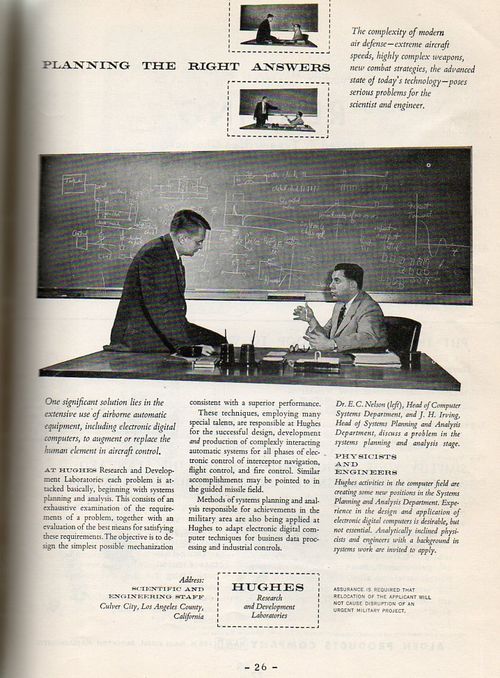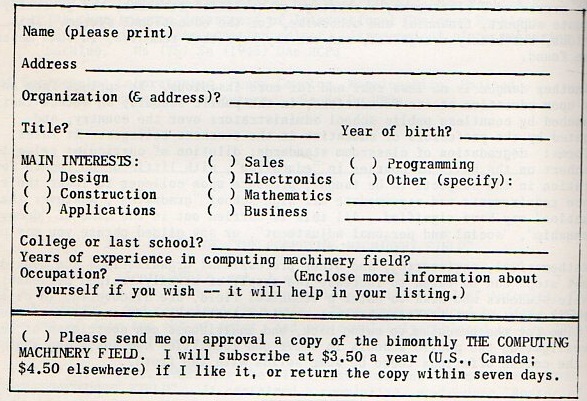Computers and Automation, published by Edmund C. Berkeley & Associates, NYC. 10.75x8.25", 8 issues for 1953, complete. 338pp, illustrations, advertisements. Bound in cloth. Provenance: U.S. Air Force AEDC Library, and then the Library of Congress. Tight copy, with a few internal stamps from the USAF and a LC surplus/duplicate rubber stamp/ VG copy. Includes significant contributions by G.M. Hopper, E. Berkeley, George Boehm, Fletcher Pratt, and many others. Scarce. SOLD
Computers and Automation, the brainchild of Edmund Berkeley, was the first popularly-published magazine published regarding the computer, its applications, it programming, and really just about everything else. (It appeared seven years after the Mathematical Tables and Aids to Computation was published in 1943, almost entirely to the mathematics and engineering communities.) CAC was published by Edmund Berkeley & Associates in NYC, beginning its publishing journey as The Computing Machinery Field, its name changing to Computers and Automation in February 1953 (in volume 2, number 2). All issues have some fair space devoted to advertising, even though the issues generally ran between 32 and 40pp. Berkeley was a mathematician, engineer and computer pioneer, but he also had a pretty large taste for making these interests pay--which was essential, as the original prxcint runs were not very large, though his advertisers were impressive. (According to the first issue, approximately 1200 people were on the mailing list for the journal, with around 2000 issues being printed each number. All told, this is not a large print run, and thus not many of the early issues have survived.) He was not averse to being somewhat outre with his journal—in addition to having contributors like Grace Hopper and Alton Householder, he also had Fletcher Pratt and Isaac Asimov writing some pretty arresting pieces from the SciFi/Futurama point of view.
A Note on the Advertisements: in short, they’re wonderful. For example, on the back cover of vol2/1 is Edmund Berkeley & Associates “SMALL ROBOTS”, advertising “Simon, the Mechanical Brains”, “Squee, the Robot Squirrel”, and other gadgets. To give you an example the other ads in this issue alone are for “The Circle Computer”, “General Ceramics Ferramic Cores”, “Magnetic Metals Co. Amplifier Cores”, Ross Ashby’s “Design for a Brain”, Consolidated Engineering’s SADIC System, Monroe Calculator’s Monrobot Electronic Calculator, George Philbrick’s “Computor (sic) products”, and a lovely two-page spread for Remington Rand. Further into the year are ads for Burroughs, IBM (604 ands 607), Electronic Associates Inc, Prokar capacitors, and many others.
Some of the subjects include: The ERA 1103 computer, NIMWIT, Applications of the Computer, what the computer *is*, Admiral Grace Murray Hopper’s compiler, mechanical translation, Harper’s subroutines, the cost of coding, computer “self-repair”, automation at Ford, and so on. Also includes perhaps the earliest announcement of the first all-transistor computer (October 1954, IBM’s “new experimental transistorized computer” , the earliest (?) printing of Asimov’s Three Laws of Robotics in a scientific journal, and more.
Each section generally has three of the following categories (per issue) : computer glossary, roster of member organizations, who’s who, an annotated books and journal section, and other aligned concerns. For example, there's this bit, an application (cut-out) card for "Who's Who in the Computing Field for December 1952"--utterly simple, it seems as though anyone who filled out the card was in, the "who's who" part of this that we normally celebrate with fame or achievement really was just telling the rest of the people in the field who was exactly who.
The contents:
Volume 2/1, January 1953. 45pp.
Householder, A.S. Brains, Electronic and Otherwise; Williams, S.B. (President, ACM) What Computers Do; Murphy, E.F. and E.C. Berkeley. Automatic Computers on Election Night.
Volume 2/2 , March 1953. 37pp.
Boehm, George A.W. Gypsy, Model VI, Claude Shannon, Nimwit and the Mouse; Paynter, Henry. Water and Computers; and the editor Berkeley, The Concept of Automation, and Berkeley (with Neil Macdonald, Berkeley’s other name). The ERA 1003 Automatic Computer
Volume 2/3, April 1953. 40pp.
Fletcher Pratt, The Art of Solving Secret Ciphers and the Digital Computer; Berkeley, Avenues for Future Development in Computing Machinery; Gene Hegedus, Hungarian Prelude to Automation..
Volume 2/4. May 1953. 33pp.
Grace Murray Hopper, Compiling Routines; A.D. Booth, Mechanical Translation; Marshall Stone, Medical Diagnosis.
Volume 2/5. July 1953.
Yehosuha Bar-Hillel (the great logician), Machine Translation; George Boehm, Robot Traffic Policemen; Rudolf Flesch, How to Talk to Computers.
Volume 2/6. September 1953.
Tommaso Fortuna, The Soviet Union: Automatic Digital Computer Research.; Wainwright, Lawrence Wainwright, Digital Computer Questionnaire; and a general DISCUSSION: “How to Talk About Computers”, with GG Hawley, Samuel Scharff, C.B. Crumb, and EC Berkeley.
Volume 2/7. October 1953. 36pp.
Brown, David W. Brown Computers in the Factory; Neil (Berkeley) Macdonald, The Flood of Automatic Computers.
Volume 2/8. November 1953. 40pp.
John W.Carr III. Who Will Man the New Digital Computers?; E.F. Cooley, Electronic Equipment Applied to Periodic Billing; Glenn.Hagen, Air-Floating: a New Principle in Magnetic Recording of Information.
Volume 2/9 December 1953. 36pp.
Clippinger, Richard Clippinger, How a Central Computing Laboratory can Help Industry; R.T. Wiseman, “Combined” Operations in a Life Insurance Company instead of “fractured operations”.
These are the contents for 1953; the volume for 1954 bulks up a little, but is still under an inch thick. The MTAC journal stays quite slender throughout its pre-1960 life (it has virtually no advertisement and is entirely academic), and there are more and more computer articles appearing in old stand-by associated journals like the Proceedings of the Institute of Radio Engineers (which by 1959 will published a massive supplemental volume called "the Computer Issue" which I'll talk about soon. For the time being, I just wanted to make an inroad into this journal--I'll expand on he articles in just a bit.






Comments